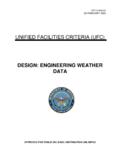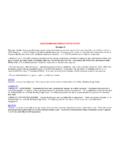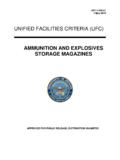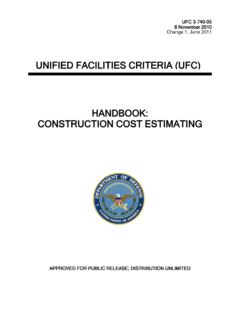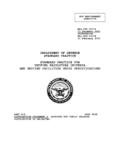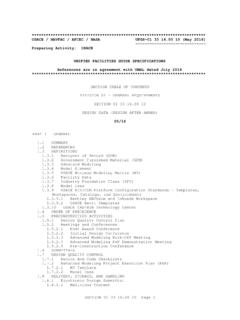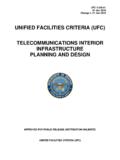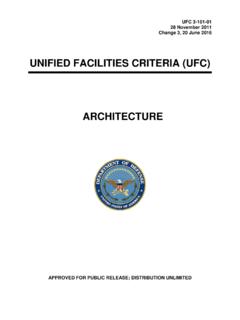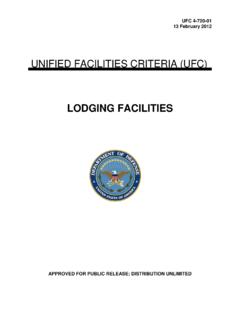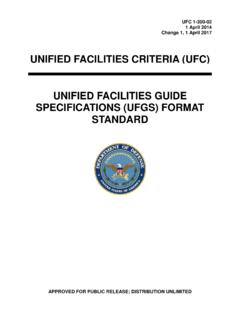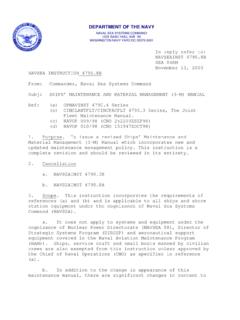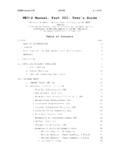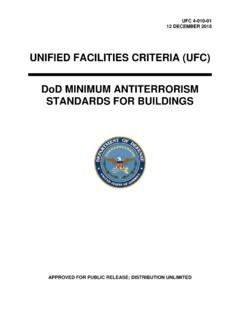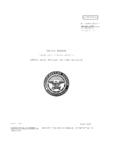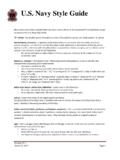Transcription of UNIFIED FACILITIES CRITERIA (UFC) - wbdg.org
1 UFC 3-535-01 11 April 2017 i UNIFIED FACILITIES CRITERIA (UFC) VISUAL AIR NAVIGATION FACILITIES APPROVED FOR PUBLIC RELEASE; DISTRIBUTION UNLIMITED CANCELLED UFC 3-535-01 11 April 2017 ii UNIFIED FACILITIES CRITERIA (UFC) VISUAL AIR NAVIGATION FACILITIES Any copyrighted material included in this UFC is identified at its point of use. Use of the copyrighted material apart from this UFC must have the permission of the copyright holder. ARMY CORPS OF ENGINEERS naval FACILITIES engineering COMMAND AIR FORCE CIVIL ENGINEER SUPPORT AGENCY (Preparing Activity) Record of Changes (changes are indicated by \1\ .. /1/) Change No. Date Location This UFC supersedes UFC 3-535-01, 17 November 2005. Electronic formatting of this document does not conform to UFC 1-300-01. CANCELLED UFC 3-535-01 11 April 2017 iii FOREWORD The UNIFIED FACILITIES CRITERIA (UFC) system is prescribed by MIL-STD 3007 and provides planning, design, construction, sustainment, restoration, and modernization CRITERIA , and applies to the Military Departments, the Defense Agencies, and the DoD Field Activities in accordance with USD (AT&L) Memorandum dated 29 May 2002.
2 UFC will be used for all DoD projects and work for other customers where appropriate. All construction outside of the United States is also governed by Status of Forces Agreements (SOFA), Host Nation Funded Construction Agreements (HNFA), and in some instances, Bilateral Infrastructure Agreements (BIA.) Therefore, the acquisition team must ensure compliance with the most stringent of the UFC, the SOFA, the HNFA, and the BIA, as applicable. UFC are living documents and will be periodically reviewed, updated, and made available to users as part of the Services responsibility for providing technical CRITERIA for military construction. Headquarters, Army Corps of Engineers (HQUSACE), naval FACILITIES engineering Command (NAVFAC), and Air Force Civil Engineer Center (AFCEC) are responsible for administration of the UFC system. Defense agencies should contact the preparing service for document interpretation and improvements.
3 Technical content of UFC is the responsibility of the cognizant DoD working group. Recommended changes with supporting rationale should be sent to the respective service proponent office by the following electronic form: CRITERIA Change Request. The form is also accessible from the Internet sites listed below. UFC are effective upon issuance and are distributed only in electronic media from the following source: Whole Building Design Guide web site Refer to UFC 1-200-01, DoD Building Code (General Building Requirements), for implementation of new issuances on projects. AUTHORIZED BY: GEORGE O. LEA, JOSEPH E. GOTT, Chief, Military engineering Branch Chief Engineer Army Corps of Engineers naval FACILITIES engineering Command EDWIN H. OSHIBA, SES, DAF MICHAEL McANDREW Deputy Director of Civil Engineers DCS/Logistics, engineering & Force Protection Deputy Assistant Secretary of Defense ( FACILITIES Investment and Management) Office of the Assistant Secretary of Defense (Energy, Installations, and Environment) CANCELLED UFC 3-535-01 11 April 2017 iv CANCELLED UFC 3-535-01 11 April 2017 v UNIFIED FACILITIES CRITERIA (UFC) REVISION SUMMARY SHEET Subject: UFC 3-535-01, Visual Air Navigation Systems Supersedes: UFC 3-535-01, 17 November 2005, which superseded Air Force Joint Manual (AFJMAN) 32-1076 and Army Technical Manual (TM) 5-811-5 Description of Changes.
4 This revision brings requirements for new airfields in compliance with new FAA CRITERIA for signage, updates taxiway lighting to include LED type fixtures ( engineering Brief 67D), provides grounding layouts for runway and taxiway lighting circuits, and updates terminal clearance heights (TCH) to comply with new and additional aircraft as requested by Air Force Flight Standards Agency. It also clarifies guidance in the superseded version for which multiple questions were fielded. Reasons for Changes: Combine Army and Air Force CRITERIA into one document. Incorporate new FAA guidance and changes. Provide information on testing and inspection of systems prior to service and information on the characteristics of an airfield lighting system Impact: Cost impact is negligible. However, the following benefit should be realized: Designers will have a better understanding of the design requirements.
5 Unification Issues Para 1-2 states the document scope. It indicates that Navy requirements are currently contained in naval Air Systems Command (NAVAIR) 51-50-AAA-2. When using the NAVAIR document, be certain that the complementary markings are installed and that no conflict occurs with the placement of light fixtures. The Navy should clarify what ..no conflict means, as it is unclear whether it references joint bases or only naval FACILITIES . Para 1-5 and 1-6: Application of this document is used for Army and Air Force. Navy uses naval Air Systems Command (NAVAIR) 51-50-AAA-2, except for excerpts contained within this document which apply specifically to Navy that are not covered in NAVAIR 51-50-AAA-2. Para 1-7: The Army and the Air Force generally follow FAA standards that are primarily published as ACs, handbooks, and specifications. However, when FAA CANCELLED UFC 3-535-01 11 April 2017 vi documents are in conflict with the Air Force or Army requirements, this UFC takes precedence.
6 For the Navy, NAVAIR 51-50-AAA-2 takes precedence. Para 1- : NATO STANAGs apply at Army and Air Force FACILITIES in NATO theater countries except the United States and Canada, or wherever NATO funding is provided for the work, regardless of location. Navy application of NATO Standardization Agreements is guided by NAVAIR 51-50-AAA-2. Para 1-10: The Army and Air Force has established tables within this document, which provide visual air navigation aids appropriate for operational requirements and associated electronic aids. See Table 2-1A, Air Force Airfield Visual FACILITIES Requirements, or Table 2-1B, US Army Airfield Visual FACILITIES Requirements. For the Navy, NAVAIR 51-50-AAA-2 identifies visual air navigation aids appropriate for operational requirements. Para 1-11 provides the Air Force process for obtaining waivers to requirements of visual air navigation aids. Para 1-12 provides the Army process for obtaining waivers to requirements of visual air navigation aids.
7 Navy waiver process is covered in NAVAIR 51-50-AAA-2. These waiver processes are geared to the individual missions of these three services. Table 2-1A provides visual FACILITIES requirements for Air Force airfields. Table 2-1B provides visual FACILITIES requirements for Army airfields. Navy visual FACILITIES requirements are provided in NAVAIR 51-50-AAA-2. These visual FACILITIES requirements are geared to the individual missions of these three services with the exception that Joint Army/Air Force bases may have additional requirements. This issue has been resolved by Army-Air Force coordination on Table 2-1A. Table 3-6 Visual Threshold Crossing Height Groups is modified and contains Army and Air Force coordinated information. Navy aircraft are not included. Figure 4-5A and Figure 4-5B provide Threshold Light Circuiting for Air Force and Army, respectively. Interleaving is not encouraged for Air Force airfields.
8 Figure 4-4A and Figure 4-4B provide Threshold Light Configurations for Air Force and Army, respectively. They differ, based on mission. Figure 4-5A and Figure 4-5B provide Threshold Light Circuiting for Air Force and Army, respectively. Interleaving is not encouraged for Air Force airfields. Figure 12-1 Counterpoise and Ground Rod Installation (Navy Only). The Air Force and Army use the method in Figure (b), 2017 NFPA 780, instead of the equipotential method used by the Navy, to avoid injecting any surge onto the airfield lighting circuits. CANCELLED UFC 3-535-01 11 April 2017 vii Para 12-3 Siting PAPI: For aircraft in height group 4 (Table 3-6) for Army airfields only, the PAPI is sited at the RPI plus an additional 300 feet (90 meters), +50 feet 0 feet (+15 meters 0 meters), from threshold. Para Threshold Crossing Height (TCH). See Table 3-6. For the Air Force, the TCH is based on the most predominant aircraft using the runway (the major command will make this determination).
9 For the Army, the TCH is based on the most demanding aircraft height group expected to use the runway (the aviation community will coordinate with US Army Aeronautical Service Agency (USAASA) for this determination). Medium Intensity Threshold/End Lighting (Army Only): See paragraph 4-4. Para In-pavement Fixtures, Bidirectional, Red/Green (Army Only). Use fixtures meeting FAA AC 150/5345-46, Type L-852D, with red and green filters where bidirectional runway end/threshold fixtures are required. If unidirectional light is required use type L-852K (green) or L-852S (red). (See Figure 13-12.) Para Where centerline lights are subject to aircraft tail hook impact use a high strength steel design designated as L-852N (NAVY). (See Figure 13-16.) CANCELLED UFC 3-535-01 11 April 2017 viii CONTENTS CHAPTER 1 INTRODUCTION TO STANDARDS AND 1 1-1 PURPOSE .. 1 1-2 SCOPE .. 1 1-3 SUMMARY OF CHANGES.
10 1 1-4 BACKGROUND .. 2 1-5 APPLICATION .. 2 1-6 NAVY REQUIREMENTS .. 2 1-7 FAA STANDARDS .. 4 1-8 INTERNATIONAL MILITARY STANDARDS .. 4 1-9 BASE RIGHTS AGREEMENTS .. 5 1- 10 VISUAL AND ELECTRONIC AIDS.. 5 1- 11 AIR FORCE WAIVERS OF REQUIREMENT .. 5 1- Approval Authority .. 6 1- Existing Air Force FACILITIES .. 7 1- 12 US ARMY WAIVERS OF REQUIREMENT .. 8 1- Waiver Procedures .. 8 1- Contents of Waiver Requests .. 9 1- Existing US Army FACILITIES .. 10 1- 13 METRICATION OF DIMENSIONS .. 10 1- 14 PHOTOMETRIC 10 1- 15 EXISTING FACILITIES .. 10 1- 16 DOCUMENT ORGANIZATION.. 11 1-17 UFC 3-535-02, Design Drawings for Visual Air Navigation FACILITIES .. 11 CHAPTER 2 APPLICATION CRITERIA .. 13 2-1 PURPOSE OF CHAPTER .. 13 2-2 RELATION TO ELECTRONIC FACILITIES .. 13 2-3 APPLICATION OF REQUIREMENTS .. 13 2-4 REQUIREMENTS .. 13 2-5 LIGHT EMITTING DIODE (LED) LIGHT FIXTURES .. 14 2- Prohibited Placements.
